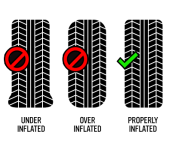fast
Contributor
I am under the impression that people make a very common mistake when it comes to how much air to put in their vehicle tires. Back in the day, I would simply look at what’s written on the tire regarding PSI (pounds per square inch). I might put a few pounds less in if my driving conditions warranted it. It was generally a good rule of thumb...but perhaps only coincidentally so.
The truth of the matter (as I’ve come to grasp and recollect again) is that the answer for the right amount of air pressure is found somewhere but NOT on the tire. All the tires tell us is the MAX PSI for that particular tire, not the correct or ideal amount of air for the tires that so happen to be on the vehicle. In others word, if you want to know about the max psi that is recommended for my specific tires, then look specifically at the tires. If you want to know the best tire pressure for the vehicle, then look at the sticker on the drivers door or owners manual.
That being said, one of my vehicles is an F-350 (that’s not a duly) and the tires say 65 max psi. The door says 65psi for front and 75psi for back.
Based on that, I should have (if my thinking is straight) 65psi in all four tires.
The truth of the matter (as I’ve come to grasp and recollect again) is that the answer for the right amount of air pressure is found somewhere but NOT on the tire. All the tires tell us is the MAX PSI for that particular tire, not the correct or ideal amount of air for the tires that so happen to be on the vehicle. In others word, if you want to know about the max psi that is recommended for my specific tires, then look specifically at the tires. If you want to know the best tire pressure for the vehicle, then look at the sticker on the drivers door or owners manual.
That being said, one of my vehicles is an F-350 (that’s not a duly) and the tires say 65 max psi. The door says 65psi for front and 75psi for back.
Based on that, I should have (if my thinking is straight) 65psi in all four tires.

